The Freak-Man
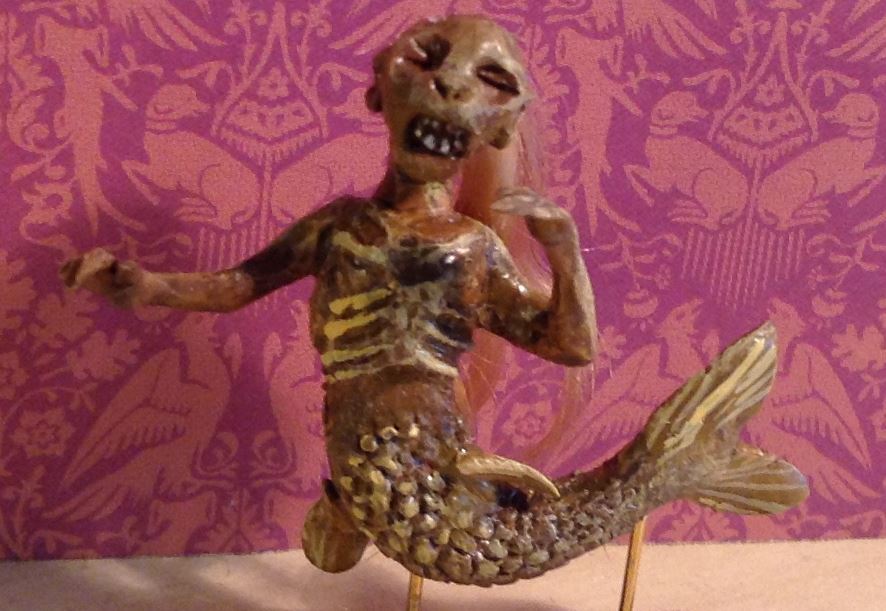
The Freak Man Feejee mermaid in miniature–3 inches long–by Jessica Wiesel.
I have a friend who makes miniatures–dolls-house miniatures for collectors–that include tiny Cabinet-of-Curiosity objects like shrunken heads, tiny mounted Jackelope and Unicorn heads, and a killer Feejee mermaid (pictured above). I’ve reported before on The Maker of Mermaids, but thought that a visit with a dime-museum freak-maker with a wider product line would be of interest.
FREAK-MAKING FOR MUSEUMS.
The Supply Keeping Pace With the Demand for Copies of Horrors.
MONSTROSITIES MADE TO ORDER.
Sea Serpents That Are More Natural Than the Original— The Wonderful
Freak, Half Boy, Half Alligator—Indian Mummies From Colorado— Pasteboard and Paper Are the Freak-Maker’s Chief Stock in Trade.
The old-time museum man, who used to take a store and put in five attractions at a gross cost of five dollars a day, has turned his attention to making inanimate freaks to be exhibited as mummified or dried specimens of the human race. This man and others made a large collection of dried mammies, sea serpents and monstrosities of all conceivable kinds for a man and he carried them over to the other side of the ocean and exhibited them in Germany, England, Ireland and Spain, and finally returned with them to this country, with a net profit, it is claimed, of $30,000 for a year’s work among the larger foreign cities.
A recent visit to a freak-maker’s little shop has enabled the writer to explain the manufacture of this kind of exhibition goods. In a small third-story front room a portly man was found at work on a two-headed mummy, which is to be exhibited as having been found in the Pyramids of Egypt. The furniture of the room suggested extreme poverty, although the stout man is able to make $40 a week at his queer trade, he lives all alone, and it is fair to presume that he is saving his money against the time when he can open a museum of the new style for his own profit.
The real appearance of one of this man’s freaks, even when it is in an unfinished state, explains why so many people are willing to accept them at the voluble museum lecturer’s valuation; and when you see the work directly under the mechanic’s hand, the excellent modeling of the face gives the object an uncanny look. These things are not modeled from life, nor does the maker ever employ an artist to assist in perfecting the anatomical intricacies of his subject. He is not an artist himself in feeling or training, but simply a workman, who, from constant practice, has been enabled to make a figure of nearly correct proportions with the crudest kind of tools.
Pasteboard and paper are his chief stock in trade. With an outer wall of soft cardboard and numerous layers of paper back of it, the head form, when well soaked in water can be pressed into a perfect semblance of the human face.
Little bits of card or paper may have to be added to accentuate the features, but when the work is ready for the pasty varnish which is to cover the first shaping and effectually adhese all its parts, these added pieces look as though they were a part of the rougher first model.
On a stove near by are gaunt representations of arms and legs, the fingers and toes made of bits of cards lapped over one another until the desired length is reached. The joinings show very plainly at this stage of the work, but when the coat of varnish covers them later and the edges of the cardboard are pressed down flat it requires a very close inspection to determine where the figures are pieced.
The anatomy of these limbs, when you take into consideration the patchwork quality of the operation, is rather wonderful. When the curious looking lot of objects are put together and the whole thing varnished brown the respectable looking mummy seems to be ready for its purchaser, but it really is not, for in the estimation of the honest workman nature has not been fully reproduced.
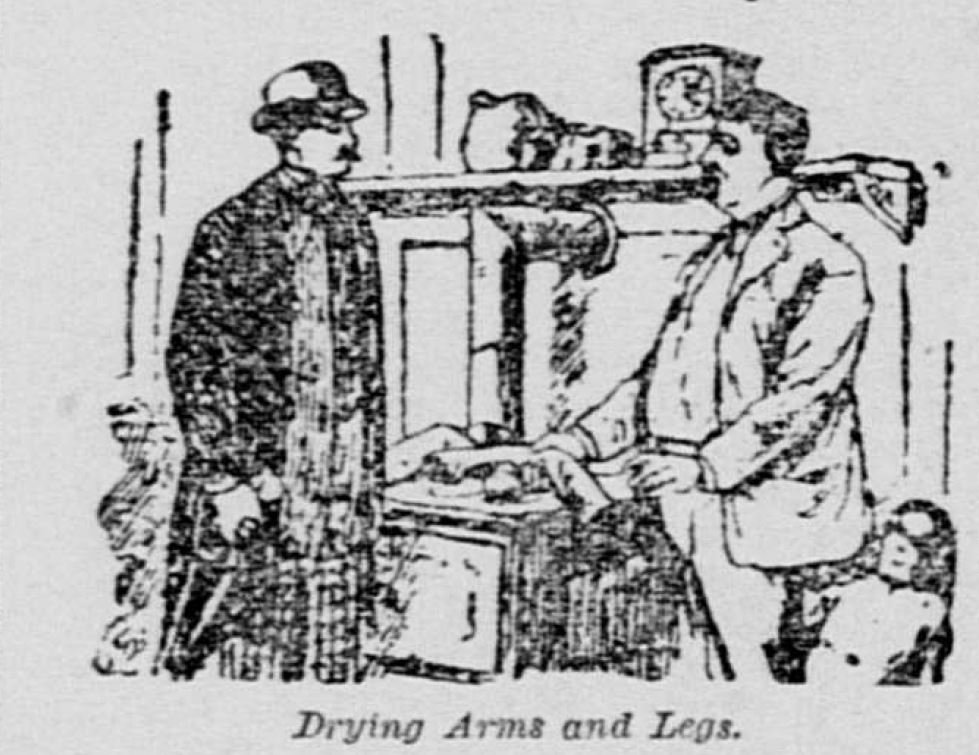
The Freak Man dries arms and legs of his manufactured freaks.
He considers that the head and hands of human beings, on account of their constant exposure to the atmosphere, have a harder cuticle than the covered portions of the body. Although it seems unnecessary that he should carry out this idea in his mechanical freaks, his next operation accomplishes just that purpose. A covering for all the body but the head and hands is made of soft, thin chamois leather. This is put on with thick paste, in pieces which will accommodate themselves to the various curves of the work. When the chamois skin is well dried on and the whole structure is carefully varnished the body parts are not only soft looking, but give somewhat at the touch as well.
Hanging on the side wall of the workshop in a carefully executed painting of Jerusalem, which at one time was part of a panorama. The freak-maker said that this painting, which is about three feet high and seven feet long, cost $200 in the old country. To explain the cost of this work in his own words: “Panoramas in the old country are very carefully made. You will notice in this piece how carefully everything is made —how the stones in the wall and the little ornaments on the temples are drawn so fine and clear. That is because in the old country the panorama makes plenty of money, arid it must be fine, for the people go in great crowds and look very carefully at pictures of the Holy Land and the Pope’s palace, and fine churches, amid all such things. They look very close at the picture, and examine it all over and talk about every little thing in it for perhaps half an hour for each one. In this country people go up to a picture and say, ‘ Oh, a picture. We don’t want to see that. Come.’ So you see on the other side the painter must be very careful and have everything good or the people will say that it is a bad work and complain to the showman.”
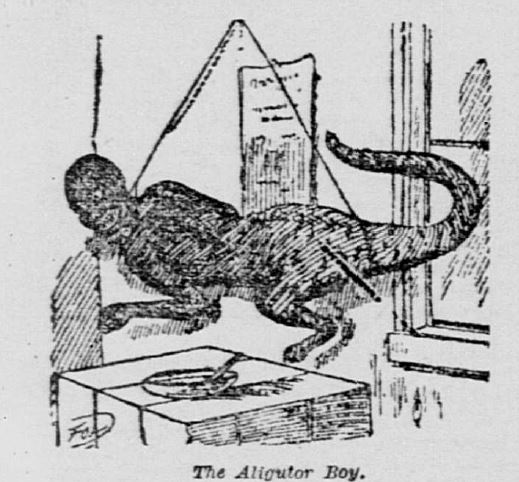
During the telling of the story of panoramic excellence in the old country, the visitor has had time to observe the various freaks in all sorts of repair hung about the room. An awful-looking object which represents an alligator-boy was placed in one corner of the room, all ready for the man who ordered it. This monstrosity is one of many of this pattern which have been turned out by the freak-man. They are all made the same size, 4 1/2 feet long, and cost only $30 each, so that an alligator-boy may be said to be within the reach of any dime museum. A repulsive-looking black body with the head turned sideways is attached to what seems to be the back half of an alligator. Real wool covers the head and real teeth are introduced in the month opening. The boy is represented as grinning in the conventional negro style.
To complete the outfit the maker furnishes the lecture to go with the freak. This insures the same story being told in all parts of the country. The lecture is a very pretty story, and we reproduce the opening of it: “In 1883 a party of alligator hunters came from England to Florida to secure some alligators. After successful hunting, returning to Jacksonville, they saw this monstrosity lying in a swamp about six miles from the city. At first they thought it was a negro, but, by going nearer to it they soon realized that it was half boy and half alligator,” etc.
One of the best of the freak-maker’s works is a double-bodied baby made to represent nature. It is not generally made as if mummified, but instead is invested with the delicate tints of life. The first one of these attracted a great deal of attention, and it was represented as the embalmed body of a real infant. There has been a great demand for this freak, and there are now a number of them in existence. As the latter ones are represented as being copies of a supposed real baby who died, the maker explains his creation in the following somewhat involved language: “After knowing the birth of double children, like represented here and taken from a photograph, occurred since the last twenty years— three times in this country—and was exhibited alive. The first ones 1871, the second ones 1878—both specimens died very young. Now born again, these children, alive, and kicking, are shown at all the museums at enormous salaries. Born in Tipton, Ind., June 24, 1889.” This tells quite a story in spite of its queer phrasing, and it always “goes,” if we may believe the lecturers who have handled the double baby. Everybody who wishes may have one for $40, in fac-simile of life or mummified.
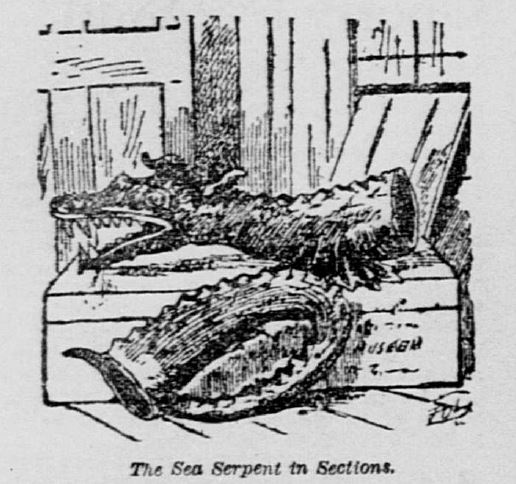
Of course the fabled sea serpent, so often seen but never caught on our coast, has furnished the text for a museum freak. The “Africanus horridus” is the name for this monstrosity. He is made somewhat after the manner described above, though his numerous protuberances along the spine have to be made of chunks of wood. When his chamois covering is on these lumps look very natural behind a glass case. A good pair of bright glass eyes and some tusks like teeth help to convince people that when alive—and, to quote the lecturer again, “shall have been captured by a party of fishermen near the coast of Maine and preserved in spirits for exhibition to the Intelligent audience,” etc.— he was a very formidable creature.
Sea serpents are $50 each and fifteen feet long in New York. The Maine fishermen cannot furnish them at this low price.
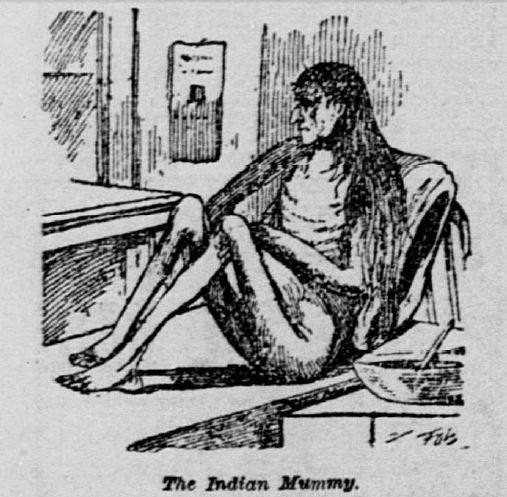
It is not hard to convince people that mummified Indians have been dug up in Dakota. The variety that is made in this city are dug up by cowboys when the lecturer gets them in hand. The Indian freak comes in two sizes— ”grown up and children,” to quote again— and the child being the cheapest, it is generally supposed that mummification is mere common among the young dead Indians than their elders.
At present the market is calling for something new. “Mermaids,” “demon children” and the “elephant fish” about close the list of artificial freaks of the pasteboard variety.
The maker guarantees to furnish any known or unknown animal if its description, sketch or photograph be furnished, but just at present there are no new ideas forthcoming, and the duplication of the stock ideas goes merrily on.
The freak man is awaiting the time when some “Cardiff giant” hoax will enable him to get a brand-new subject for dissemination among the hundreds of dime museums between New York and the Pacific Slope, and he fondly hopes to be able to employ a corps of assistants to help him fill his orders. As it is, while he is never able to carry a stock of made-up goods, his orders do not warrant the giving away to other men of his trade secrets. Some of them appear here, it is true, but not all, for there are niceties in the work that no amount of description could give, and the trick of making a little work produce a great effect is one of his most vaunted accomplishments. It is this trick that leads him to advertise himself as the “greatest imitator of natural subjects in the world,” and he deserves the title, so the museum men say. N.Y. Herald
The San Francisco [CA] Call 16 November 1890: p. 15
The sea serpent reminds me of a crocodile stage costume as pictured below by John Leech in Punch. The “alligator boy” and the Native American mummies reflect the usual uncomfortably casual racism of the time.
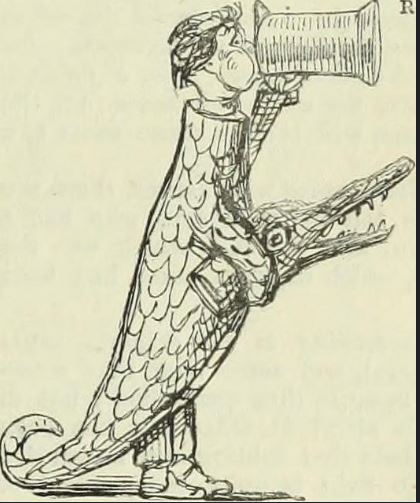
Crocodile costume 1841, Punch
Although I’ve written about the Japanese Devil skeleton and fashions in freaks, I haven’t yet found a detailed interview with the maker of that wildly popular freak, the “Devil Kid” or “Demon Child,” the unholy spawn, usually of an immigrant family, born with horns, hooves, and a tail. Other freak maker interviews? Send to chriswoodyard8 AT gmail.com, who has the trick of making a little work produce a great effect.
Chris Woodyard is the author of The Victorian Book of the Dead, The Ghost Wore Black, The Headless Horror, The Face in the Window, and the 7-volume Haunted Ohio series. She is also the chronicler of the adventures of that amiable murderess Mrs Daffodil in A Spot of Bother: Four Macabre Tales. The books are available in paperback and for Kindle. Indexes and fact sheets for all of these books may be found by searching hauntedohiobooks.com. Join her on FB at Haunted Ohio by Chris Woodyard or The Victorian Book of the Dead. And visit her newest blog, The Victorian Book of the Dead..
